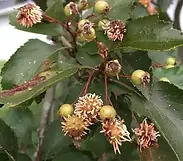



Insect Control




Have you seen black leaves on your trees and shrubs?
Don't let your plants turn into a buffet!
There are many pesky insects that can make a buffet out of your trees and shrubs. It is important to correctly identify the plant and the insect species before any type of treatment begins. Sap sucking insects are easier to detect than boring insects and a Pine tree functions differently than a Maple tree. Our experienced arborists can correctly identify your trees and shrubs, recognize the presence of damaging insects and recommend the correct treatment options. To protect trees and shrubs from damaging insects we apply Insecticides and Horticultural Oils.
Frequently Damaged Tree & Shrub Species
--- Maple, River Birch, Willow, Sycamore, Ash, Linden, Hemlock, Arborvitae, Magnolia, Rose Bushes, Laurels, Boxwood, Azalea ----

Mites are a common pest living in most landscapes. However, mite damage is often diagnosed incorrectly resulting in wasteful treatments and increased plant damage. Mites regenerate rapidly during drought conditions. Also, popular insecticides do NOT control mite pests. In fact, they kill off beneficial insects and can cause mite populations to grow faster. It is important to anticipate the presence of mite pests and incorporate mite control into every Plant Health Care Program. - To protect trees and shrubs from damaging Mites we apply Miticides and Horticultural Oils as well as monitor and maintain soil moisture when necessary.
Frequently Damaged Tree & Shrub Species
---- Spruce, Arborvitae, Holly, Juniper, Fir, Maple, Oak, Boxwood, Euonymus (Burning Bush), annual and perennial bedding plants----
Mite Control




If mite populations are not controlled, your landscape may suffer irreversible damage.
Mites are very small and difficult to see
without magnification.

Disease Control




A damaging disease can be controlled or even prevented when your landscape is protected by Live Long Tree & Shrub Care.
Damage from disease isn't just unattractive. It causes a lot of stress on a plant and weakens its defenses from insect and mite pests.


Tree and Shrub pests aren't just limited to insects and mites. Disease can be responsible for early defoliation, short or poor blooms, stunted growth, leaf spots and many other symptoms associated with decline. Pathogens that cause disease remain present in our landscapes waiting to attack a stressed or weakened plant. During conditions which favor the development of disease, preventive treatment against infection is crucial. Diseases are opportunistic and limiting any opportunity a pathogen may have to infect a healthy tree or shrub is an essential part of Integrated Pest Management (IPM). - To protect trees and shrubs from infections we apply Fertilizers, Plant Growth Regulators, Fungicides and Bactericides as well as practicing proper maintenance methods to improve vigor and promote healthy growth.
Frequently Damaged Tree & Shrub Species
---- Dogwood, Crabapple, Beech, Hawthorne, Ornamental Pear, Cherry, Sycamore, Pachysandra, Rose Bushes, Hydrangea, Forsythia, Lilac, Laurel ----